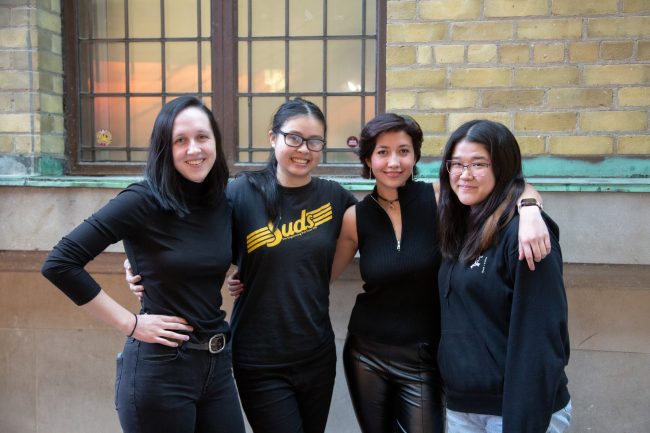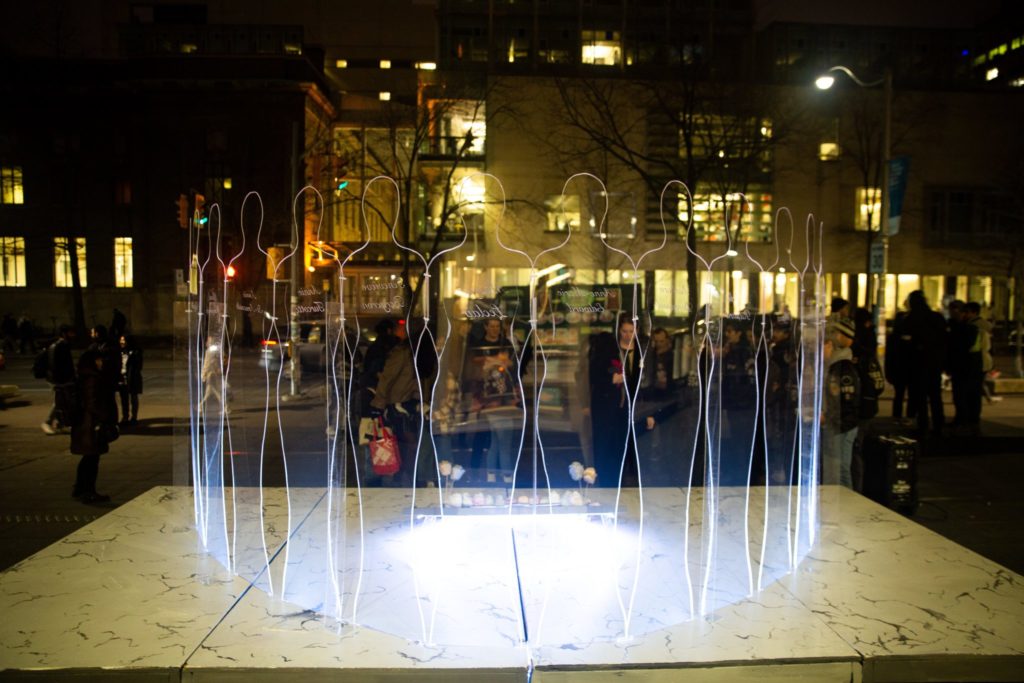
On a dark evening in December 2022, members of the U of T Engineering community gathered in front of the Galbraith Building to unveil a student-built monument commemorating the National Day of Remembrance and Action on Violence Against Women.
Fourteen transparent figures stood on a wooden platform, each bearing the name of one of the 14 women killed on December 6, 1989, when an antifeminist gunman entered the École Polytechnique and targeted students who were women.
The monument, designed and built by a group of women engineering students, was interactive: its colours changed and got brighter depending on how many people were standing on a pressure-sensitive pad concealed under nearby grass turf.
“The symbolism was that you can’t make change by yourself — we have to all work together,” says Erika Narimatsu (Year 3 MechE).
Ahead of February 11, the International Day of Women and Girls in STEM, writer Safa Jinje spoke with four of the women who led the creation of the monument: Narimatsu, Stella Gregorski (Year 4 ChemE), Natalia (Nat) Espinosa-Merlano (Year 3 MechE) and Karen Ng (Year 3 ECE).
Why did you choose to build the December 6 monument? How did your team come together?
Narimatsu: The idea was floated around that it would be really cool if this build was led by women because it is about women. It’s about acknowledging the sexism and all the discrimination women face, especially in engineering.
We had a lot of support from our colleagues — we had a team of 30 to 40 people working on this — and support also from the Faculty’s Office of Diversity, Inclusion and Professionalism with funding, being there for us and showing up to the ceremony.
Ng: It was really nice for people to trust that we knew what we were doing and believe in our plans and just say, ‘how can we help?’
Espinosa-Merlano: Historically, the Blue & Gold committee has led this build. But since we felt that such an intimate build should be led by a group of women, all Blue and Gold did this year was provide tools and expertise. We planned, coordinated and brought the build to life. I am, of course, one of the Blue & Gold co-chairs, but for me, this project was about more than that.
For this build, we wanted our leadership to be showcased. It was about being a woman, stepping out of the shadows and taking charge.
Gregorski: Growing up in the U.S., I didn’t know about December 6, or the National Day of Remembrance and Action on Violence Against Women, until my first year in university. But afterwards, I talked with my mom about it.
My mom was in her senior year of her first engineering degree in 1989, when the massacre happened. She told me how terrifying that was, as someone who was in the same exact situation as those young women.
But what I found really powerful, in talking to her about it, is she did it anyway. And when I said ‘Mom, this is what I want to do,’ she encouraged me. She said, ‘If that’s what you want to do, you go do it.’
We can’t let fear stop us. At the end of the day, that’s not how progress is made.

From your experience, what do you think are some of the barriers that would prevent girls or women from pursuing an education or career in STEM fields?
Gregorski: Obviously, we are incredibly fortunate to live and study in a country like Canada where broadly speaking, women’s rights have come a long way even if they do still have a long way to go.
I’m from the United States — there, we see backtracking on that every single day such as limiting access to health care and reproductive rights, and specifically the stigmatizing of women’s health.
And then you have other countries. In Iran, we see a mass uprising about women’s rights. The condition of women in many countries has so far to go. I think we all have a role to play in making sure that all women everywhere have the same rights that we do.
But even within Canada, not being able to see people who look like you [in STEM fields] and feeling that you don’t really belong or not feeling supported, I would say are still big barriers.
Ng: One barrier that comes to mind is that we limit women who do go into STEM and discourage prevent them from staying in the fields. I feel like I have to put in 120% to be perceived as putting in 80.
I recall a time in high school when I was entering a robotics competition. I was so excited to join the team. It was all guys and me and one other woman. And the teacher that was in charge looked at all of us and pointed to me and the other woman and said, ‘Do you to want to be in charge of fundraising?’ I felt that so deeply. But I also thought, ‘Well, now I have to do everything better than all of these people combined.’
Narimatsu: I also fundraised for my robotics team — for the exact same reason!
What advice do you have for girls who are interested in pursuing STEM in university?
Narimatsu: Just do it! You might have to carve a path for yourself, make that space and be loud. But at the end of the day, if that’s what you want to do, go for it.
Gregorski: Don’t be afraid to ask for help. There are people who will support you. We may have a long way to go in terms of making these fields equal for women, but people are blazing that path.
Ng: There are people like you out there and they want to see you succeed as well. Just do what it takes — what other choice do we have?
Espinosa-Merlano: You don’t necessarily have to be cynical or pessimistic but try to have that sense of critical thinking: knowing what’s right for you and being confident in who you are and what you are worth.
– This story was originally published on the University of Toronto’s Faculty of Applied Science and Engineering News Site on February 10, 2023 by Safa Jinje